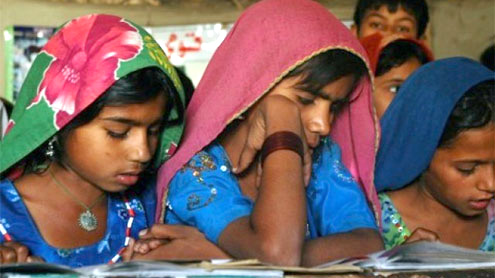
Despite the massive budgetary allocation of Rs111 billion for education, Sindh’s managers have failed to make a mark, a glaring example of which is the fact that the number of children in the province having no access to primary education has increased.
These observations are part of the Annual Status of Education Report (ASER) Pakistan that portrays a dismal picture of the state of education in Pakistan, especially in Sindh.The survey was conducted by ASER in collaboration with the Information and Communication Resource Programme (HANDS), the Sindh Education Foundation and the National Commission for Human Development. It was funded by SAFED and Oxfam.Speaking at a news conference at the Karachi Press Club, ASER Research Associate Ansar Shah said the report would be released in Islamabad on January 21 and in Sindh on 31st.
The survey was conducted in 136 rural and six urban districts. They included all of Sindh’s 23 districts. It took cognisance of school-going children’s attendance and absence and those who were never admitted to a school.Shah said according to the ASER 2011, 20 percent of children across the country had no access to primary education. In Sindh, the ratio was 30 percent, 50 percent of them girls. “According to ASER 2012, the ratio has increased,” he added.
Shah further said the 2011 survey indicated that 68 percent of schools lacked toilets and 53 had poor drinking water facilities. Thirty percent of them lacked boundary walls.“In 2012,” he added, “no progress was made in these areas.”Citing the report, Shah said the Sindh government had allocated Rs111 billion for education, but as this money was not properly utilised, the state of education in the province was showing signs of further deterioration.“Better results can be achieved if funds allocated for education are judiciously utilised.”
Shah said certain tools were used in the survey and more than 50 percent students of class V were unable to read any other language other than their own.“Children were asked to read capital letters, small letters and a sentence and if children studying in a school could not read capital letters, they were ticked as illiterate.”Responding to a question, Shah said he was a political scientist and immensely inspired by the great Italian Marxist thinker, Antonio Gramsci, who presented the concept of organic intellectuals.
“There are 60 secondary schools in country for every 600 primary schools. Our education system is flawed.”Shah was flanked by HANDS General Manager Bilquis Rehman and Mujib-ur-Rahman Khatri.ASER operates at the national, provincial, district and village levels,” said Rehman. “At the national level, it’s governed by international non-governmental organisations,” she added.“Education should be made one of the main agendas prior to the general elections because it’s the right of every child.”
The HANDS general manager also pointed out that the government owned the report.“By the year 2015, we have to push our literacy rate to 85 percent in accordance with the Millennium Development Goals. ASER is analysing the quality of education and its compatibility.”Rehman said the survey was conducted by several non-governmental organisations and volunteers were trained for three days to carry out the task. “Citizens themselves carried out the survey; so there is no monopoly.”She said the report was sent to the media, executive district officers, politicians and all other stakeholders.
To a question, she said both government and private schools were surveyed.“Essentially,” she noted, “it’s a rural-based survey.”A documentary was also shown on the occasion. It revealed that 10 percent of world’s children who do not go to schools live in Pakistan.The documentary also focused on issues related to gender, drinking water facilities and the role a mother plays in rearing her children if she is literate. – TheNews












